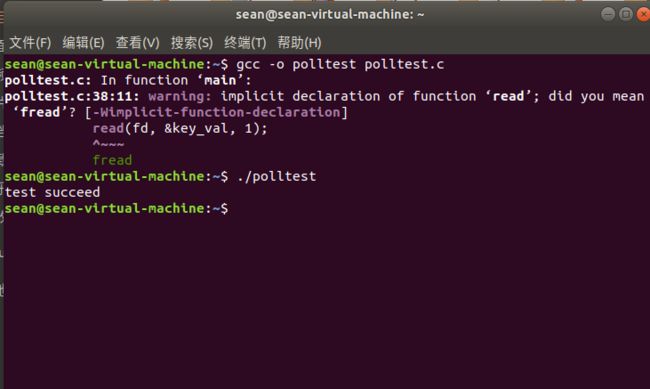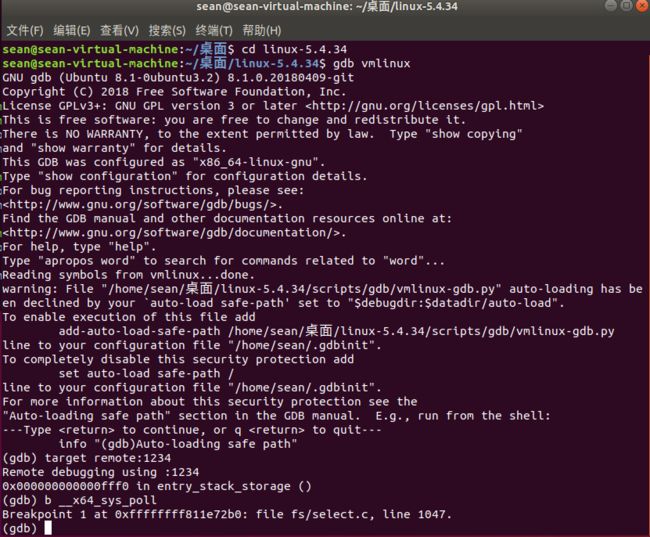实验要求
- 找一个系统调用,系统调用号为学号最后2位相同的系统调用
- 通过汇编指令触发该系统调用
- 通过gdb跟踪该系统调用的内核处理过程
- 重点阅读分析系统调用入口的保存现场、恢复现场和系统调用返回,以及重点关注系统调用过程中内核堆栈状态的变化
实验内容
查找系统调用
查看linux内核arch/x86/entry/syscalls/syscall_64.tbl下的64位x86系统对应的系统调用表,并找到07所对应的系统
调用号。
根据上图可以看出,07所对应的系统调用为__x64_sys_poll,其对应的API函数为poll。
编写汇编代码触发系统调用
查阅相关资料得知,poll()函数功能为:在指定时间内轮询一定数量的文件描述符,来测试其中是否有就绪者,
int poll(struct pollfd* fds, nfds_t nfds, int timeout);
其中:
(1)fds是一个pollfd结构类型的数组,它指定所有我们感兴趣的文件描述符上发生的可读、可写和异常等事件。pollfd结构体如下:
(2)nfds指定被监听事件集合fds的大小
(3)timeout指定poll的超时值,当timeout为-1时poll调用将永远阻塞,直至某个时间发生,而当timeout为0时,poll调用将会立即返回。
我们通过编写一个程序来测试poll的具体功能,测试代码如下:
#include#include #include #include #include int main(int argc, char **argv) { int fd; char* filename="1.txt"; unsigned long cnt=0; int ret; struct pollfd *key_fds;//定义一个pollfd结构体key_fds fd = open(filename, O_RDWR); if (fd < 0)//小于0说明没有成功 { printf("error, can't open %s\n", filename); return 0; } if(argc !=1) { printf("Usage : %s ",argv[0]); return 0; } key_fds ->fd = fd;//文件 key_fds->events = POLLIN;//poll直接返回需要的条件 while(1) { ret = poll(key_fds, 1, 5000);//调用sys_poll系统调用,如果5S内没有产生POLLIN事件,那么返回,如果有POLLIN事件,直接返回 if(!ret) { printf("time out\n"); } else { if(key_fds->revents==POLLIN) { printf("test succeed\n"); } } } return 0; }
该程序对指定文件设置监听事件POLLIN,也即是读事件,时间设为5s,若5s内发生读事件,则返回成功并打印:
在了解了poll系统调用的基本功能后,我们接下来通过编写汇编代码来触发系统调用:
#include#include #include #include #include #include #include int main(int argc, char **argv) { int fd; char* filename="1.txt"; int key_val; int ret; struct pollfd *key_fds;//定义一个pollfd结构体key_fds fd = open(filename, O_RDWR); if (fd < 0)//小于0说明没有成功 { printf("error, can't open %s\n", filename); return 0; } if(argc !=1) { printf("Usage : %s ",argv[0]); return 0; } key_fds ->fd = fd; key_fds->events = POLLIN; //ret = poll(key_fds, 1, 5000); int b1 = 1; int b2 = 5000; asm volatile( "movq %3, %%rdx\n\t" "movq %2, %%rsi\n\t" "movq %1, %%rdi\n\t" "movl $0x07, %%eax\n\t" "syscall\n\t" "movq %%rax, %0\n\t" :"=m"(ret) :"b"(key_fds),"c"(b1),"d"(b2) ); if(!ret) { printf("time out\n"); } else { if(key_fds->revents==POLLIN) { read(fd, &key_val, 1); printf("test succeed\n"); } } return 0; }
gdb跟踪分析系统调用过程
首先是环境配置
安装开发工具
sudo apt install build-essential sudo apt install qemu # install QEMU sudo apt install libncurses5-dev bison flex libssl-dev libelf-dev
下载内核源代码
sudo apt install axel axel -n 20 https://mirrors.edge.kernel.org/pub/linux/kernel/v5.x/ linux-5.4.34.tar.xz xz -d linux-5.4.34.tar.xz tar -xvf linux-5.4.34.tar cd linux-5.4.34
配置内核编译选项
make defconfig # Default configuration is based on 'x86_64_defconfig'
make menuconfig
# 打开debug相关选项
Kernel hacking --->
Compile-time checks and compiler options --->
[*] Compile the kernel with debug info
[*] Provide GDB scripts for kernel debugging
[*] Kernel debugging
# 关闭KASLR,否则会导致打断点失败
Processor type and features ---->
[] Randomize the address of the kernel image (KASLR)
编译内核
make -j$(nproc) # nproc gives the number of CPU cores/threads available # 测试⼀下内核能不能正常加载运⾏,因为没有⽂件系统终会kernel panic qemu-system-x86_64 -kernel arch/x86/boot/bzImage # 此时应该不能正常运行
制作根文件系统
#下载 axel -n 20 https://busybox.net/downloads/busybox-1.31.1.tar.bz2 tar -jxvf busybox-1.31.1.tar.bz2 cd busybox-1.31.1
#制作根文件系统
make menuconfig
#记得要编译成静态链接,不⽤动态链接库。
Settings --->
[*] Build static binary (no shared libs)
#然后编译安装,默认会安装到源码⽬录下的 _install ⽬录中。
make -j$(nproc) && make install
制作内存根文件系统镜像
mkdir rootfs
cd rootfs
cp ../busybox-1.31.1/_install/* ./ -rf
mkdir dev proc sys home
sudo cp -a /dev/{null,console,tty,tty1,tty2,tty3,tty4} dev/
准备init脚本文件放在根文件系统跟目录下(rootfs/init),添加如下内容到init文件。
#!/bin/sh mount -t proc none /proc
mount -t sysfs none /sys echo "Wellcome SeanOS!"
echo "--------------------" cd home /bin/sh #给init脚本添加可执行权限 chmod +x init #打包成内存根文件系统镜像 find . -print0 | cpio --null -ov --format=newc | gzip -9 > ../rootfs.cpio.gz #测试挂载根文件系统,看内核启动完成后是否执行init脚本
cd .. qemu-system-x86_64 -kernel ../linux-5.4.34/arch/x86/boot/bzImage -initrd rootfs.cpio.gz
至此环境配置完毕。
下面我们将生成的之前编写的c文件的可执行文件文件拷贝至rootfs/home文件夹下,最后,由于我们对系统做了修改,需要重新打包成内存根文件系统镜像。因此要再次使用命令:
find . -print0 | cpio --null -ov --format=newc | gzip -9 > ../rootfs.cpio.gz
再次启动qemu,发现home里出现了我们刚才复制的两个文件:
下面进行gdb调试工作:
首先执行
qemu-system-x86_64 -kernel linux-5.4.34/arch/x86/boot/bzImage -initrd rootfs.cpio.gz -S -s -nographic -append "console=ttyS0"
之后再打开个终端,在对应的系统调用入口处打好断点后,执行polltest应用程序,并在gdb调试中使用bt查看当前堆栈。
poll系统调用成功执行。用bt查看堆栈:
可以看到系统调用的入口在entry_SYSCALL_64(),找到该处的代码:
ENTRY(entry_SYSCALL_64) UNWIND_HINT_EMPTY /* * Interrupts are off on entry. * We do not frame this tiny irq-off block with TRACE_IRQS_OFF/ON, * it is too small to ever cause noticeable irq latency. */ swapgs /* tss.sp2 is scratch space. */ movq %rsp, PER_CPU_VAR(cpu_tss_rw + TSS_sp2) SWITCH_TO_KERNEL_CR3 scratch_reg=%rsp movq PER_CPU_VAR(cpu_current_top_of_stack), %rsp /* Construct struct pt_regs on stack */ pushq $__USER_DS /* pt_regs->ss */ pushq PER_CPU_VAR(cpu_tss_rw + TSS_sp2) /* pt_regs->sp */ pushq %r11 /* pt_regs->flags */ pushq $__USER_CS /* pt_regs->cs */ pushq %rcx /* pt_regs->ip */
swapgs指令以类似快照的方式通过CPU内部的存储器,将保存现场和恢复现场时的寄存器保存起来,然后将pt_regs中的相关字段保存到内核栈中。
紧接着,调用了do_syscall_64,代码如下
GLOBAL(entry_SYSCALL_64_after_hwframe) pushq %rax /* pt_regs->orig_ax */ PUSH_AND_CLEAR_REGS rax=$-ENOSYS TRACE_IRQS_OFF /* IRQs are off. */ movq %rax, %rdi movq %rsp, %rsi call do_syscall_64 /* returns with IRQs disabled */
先将rax中的值保存在了栈中,然后通过rdi,rsi进行传参,其中rdi传递的是系统调用号,rsi传递的是pt_regs
函数do_syscall_64()的代码如下
#ifdef CONFIG_X86_64 __visible void do_syscall_64(unsigned long nr, struct pt_regs *regs) { struct thread_info *ti; enter_from_user_mode(); local_irq_enable(); ti = current_thread_info(); if (READ_ONCE(ti->flags) & _TIF_WORK_SYSCALL_ENTRY) nr = syscall_trace_enter(regs); if (likely(nr < NR_syscalls)) { nr = array_index_nospec(nr, NR_syscalls); regs->ax = sys_call_table[nr](regs); #ifdef CONFIG_X86_X32_ABI } else if (likely((nr & __X32_SYSCALL_BIT) && (nr & ~__X32_SYSCALL_BIT) < X32_NR_syscalls)) { nr = array_index_nospec(nr & ~__X32_SYSCALL_BIT, X32_NR_syscalls); regs->ax = x32_sys_call_table[nr](regs); #endif } syscall_return_slowpath(regs); }
在该函数中,通过传入的系统调用号nr找到相应的系统调用,并将返回值保存在regs的ax中。
调用结束后,执行syscall_return_slowpath,进行返回。
然后在gdb单步调试中,我们可以看到从syscall_return_slowpath返回后,开始恢复现场。主要是将之前保存在栈中的寄存器的值,重新恢复到原来的寄存器中。
![]()
系统调用返回,由内核态回到用户态。








